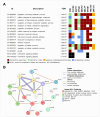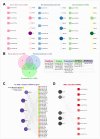Integrated Computational Analysis Reveals Early Genetic and Epigenetic AML Susceptibility Biomarkers in Benzene-Exposed Workers
- PMID: 39940906
- PMCID: PMC11818736
- DOI: 10.3390/ijms26031138
Integrated Computational Analysis Reveals Early Genetic and Epigenetic AML Susceptibility Biomarkers in Benzene-Exposed Workers
Abstract
Benzene, a well-known carcinogenic airborne pollutant, poses significant health risks, particularly in industries such as petroleum, shoemaking, and painting. Despite strict regulations, chronic occupational exposure persists, contributing to the onset of acute myeloid leukemia (AML) and other malignancies. Benzene's carcinogenicity stems from its metabolic activation, leading to increased oxidative stress, DNA damage, and cancer transformation. While its toxicity is well-documented, the link between genetic and epigenetic alterations and cancer susceptibility in exposed workers remains underexplored. This study aims to identify early biomarkers of benzene exposure and AML risk by analyzing gene expression and DNA methylation datasets from GEO DataSets, integrated with molecular pathway analyses, as well as miRNA-target and protein-protein network evaluations. This multi-approach led to the identification of nine deregulated genes (CRK, CXCR6, GSPT1, KPNA1, MECP2, MELTF, NFKB1, TBC1D7, ZNF331) in workers exposed to benzene, with NFKB1 showing strong discriminatory potential. Also, dose-dependent DNA methylation changes were observed in CXCR6 and MELTF, while selected miRNAs such as let-7d-5p, miR-126-3p, and miR-361-5p emerged as key post-transcriptional regulators. Furthermore, functional enrichment linked these genes to immune response, inflammation, cell proliferation, and apoptosis pathways. While network analyses highlighted NFKB1, CRK, and CXCR6 as central to benzene-associated leukemogenesis. Altogether, these findings provide novel insights into an early biomarker fingerprint for benzene exposure and AML susceptibility, supporting the future development of biomolecular-based targeted occupational health monitoring and personalized preventive strategies for at-risk workers.
Keywords: DNA methylation; acute myeloid leukemia; benzene exposure; computational study; gene expression; miRNA regulatory network; occupational biomarkers; occupational health; risk assessment.
Conflict of interest statement
The authors declare no conflicts of interest.
Figures









Similar articles
-
Up-regulation of DNMT3b contributes to HOTAIRM1 silencing via DNA hypermethylation in cells transformed by long-term exposure to hydroquinone and workers exposed to benzene.Toxicol Lett. 2020 Apr 1;322:12-19. doi: 10.1016/j.toxlet.2019.12.028. Epub 2019 Dec 30. Toxicol Lett. 2020. PMID: 31899212
-
Identification of the key genes and microRNAs in adult acute myeloid leukemia with FLT3 mutation by bioinformatics analysis.Int J Med Sci. 2020 May 18;17(9):1269-1280. doi: 10.7150/ijms.46441. eCollection 2020. Int J Med Sci. 2020. PMID: 32547322 Free PMC article.
-
Leukemia mortality by cell type in petroleum workers with potential exposure to benzene.Environ Health Perspect. 1996 Dec;104 Suppl 6(Suppl 6):1381-92. doi: 10.1289/ehp.961041381. Environ Health Perspect. 1996. PMID: 9118924 Free PMC article.
-
A clandestine culprit with critical consequences: Benzene and acute myeloid leukemia.Blood Rev. 2021 May;47:100736. doi: 10.1016/j.blre.2020.100736. Epub 2020 Jul 22. Blood Rev. 2021. PMID: 32771228 Review.
-
Shanghai Health Study (2001-2009): What was learned about benzene health effects?Crit Rev Toxicol. 2018 Mar;48(3):217-251. doi: 10.1080/10408444.2017.1401581. Epub 2017 Dec 15. Crit Rev Toxicol. 2018. PMID: 29243948 Review.
References
-
- IARC Working Group on the Evaluation of Carcinogenic Risks to Humans . Benzene—IARC Monographs on the Evaluation of Carcinogenic Risks to Humans, No. 120. World Health Organization; Geneve, Switzerland: 2018.
-
- European Parliament. Council of the European Union Directive (EU) 2022/431 of the European Parliament and of the Council of 9 March 2022 amending Directive 2004/37/EC on the protection of workers from the risks related to exposure to carcinogens or mutagens at work. Off. J. Eur. Union. 2022;50:1–14.
MeSH terms
Substances
LinkOut - more resources
Full Text Sources
Medical
Miscellaneous

